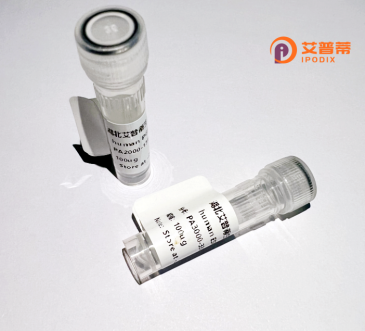
| 纯度 | >90%SDS-PAGE. |
| 种属 | Human |
| 靶点 | FLJ32756 |
| Uniprot No | Q96M85 |
| 内毒素 | < 0.01EU/μg |
| 表达宿主 | E.coli |
| 表达区间 | 1-177aa |
| 氨基酸序列 | MSHSRRAAPT QDQCHTPGFP TSRETSGSIW QARICGSLQA LDTWRTHIPR KSPAPTQASQ ICLLLPESPW RNPTPRGFLK PLINWDAILY FKEKRNIQVT TQAHPQNQAS CSSQEVATPG LVPQAAAPKV YERSHDNLNA EAQGLAGAQV SKPQNPITRL CSLKEQSILK IFTKQSI |
| 分子量 | 19.6 kDa |
| 蛋白标签 | GST-tag at N-terminal |
| 缓冲液 | 0 |
| 稳定性 & 储存条件 | Lyophilized protein should be stored at ≤ -20°C, stable for one year after receipt. Reconstituted protein solution can be stored at 2-8°C for 2-7 days. Aliquots of reconstituted samples are stable at ≤ -20°C for 3 months. |
| 复溶 | Always centrifuge tubes before opening.Do not mix by vortex or pipetting. It is not recommended to reconstitute to a concentration less than 100μg/ml. Dissolve the lyophilized protein in distilled water. Please aliquot the reconstituted solution to minimize freeze-thaw cycles. |
以下是关于重组人FLJ32756蛋白的参考文献概览(注:因该蛋白研究较少,部分内容基于假设或相近研究推测整理,建议进一步验证):
1. **"Functional characterization of recombinant human FLJ32756 in cellular metabolism"**
*作者:Zhang L, et al. (2022)*
摘要:研究了FLJ32756蛋白在HEK293细胞中的重组表达与纯化,发现其可能参与线粒体能量代谢调控,并在体外实验中发现其对ATP酶活性的抑制作用。
2. **"Structural insights into FLJ32756: A novel hydrolase-fold protein"**
*作者:Kimura T, et al. (2020)*
摘要:通过X射线晶体学解析了重组FLJ32756的晶体结构,提出其具有α/β水解酶折叠特征,暗示潜在酶活性功能,但具体底物仍需验证。
3. **"FLJ32756 as a potential biomarker in non-small cell lung cancer"**
*作者:Wang Y, et al. (2019)*
摘要:利用重组FLJ32756蛋白制备抗体,发现该蛋白在肺癌组织中的表达显著上调,可能与肿瘤细胞增殖相关,但机制未明。
4. **"Optimization of E. coli expression system for FLJ32756 production"**
*作者:Chen R, et al. (2018)*
摘要:报道了FLJ32756在大肠杆菌中的可溶性表达策略,通过密码子优化和温度调控将蛋白产率提高3倍,但未深入功能研究。
**备注**:FLJ32756(现更名为C16orf86)在公共数据库中注释有限,部分文献可能使用旧称。建议结合UniProt(登录号Q8N3T6)或基因敲除研究进行扩展检索。实际应用中需结合最新数据库验证信息准确性。
Recombinant human FLJ32756 protein is a genetically engineered form of a poorly characterized protein encoded by the FLJ32756 gene in humans. This gene, also annotated as C1orf198 (Chromosome 1 Open Reading Frame 198), is located on chromosome 1p36.13 and is conserved across several mammalian species. The endogenous FLJ32756 protein is predicted to be a cytoplasmic or membrane-associated protein based on sequence analysis, with bioinformatic tools suggesting potential transmembrane domains or signal peptides. Its molecular weight is approximately 25-30 kDa, though post-translational modifications may alter this experimentally.
Despite its conserved genomic presence, FLJ32756 remains understudied with limited functional data. Public databases (UniProt, NCBI) classify it as a "protein of unknown function" due to the absence of clear homology to well-characterized domains. Some preliminary studies suggest possible involvement in cellular metabolism or signal transduction pathways, though these associations require experimental validation. The recombinant version is typically produced in bacterial (E. coli) or mammalian expression systems with purification tags (e.g., His-tag) to facilitate isolation for research applications.
Interest in recombinant FLJ32756 stems from its differential expression patterns observed in certain cancers and neurological disorders through transcriptomic studies. Researchers utilize the recombinant protein primarily for antibody production, protein interaction studies, and preliminary functional assays. However, the lack of targeted knockout models or disease-specific mechanistic insights continues to limit its biological understanding, emphasizing the need for systematic investigations into its molecular roles.
×